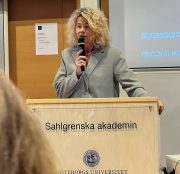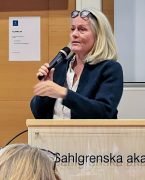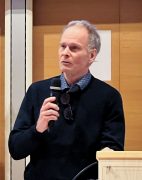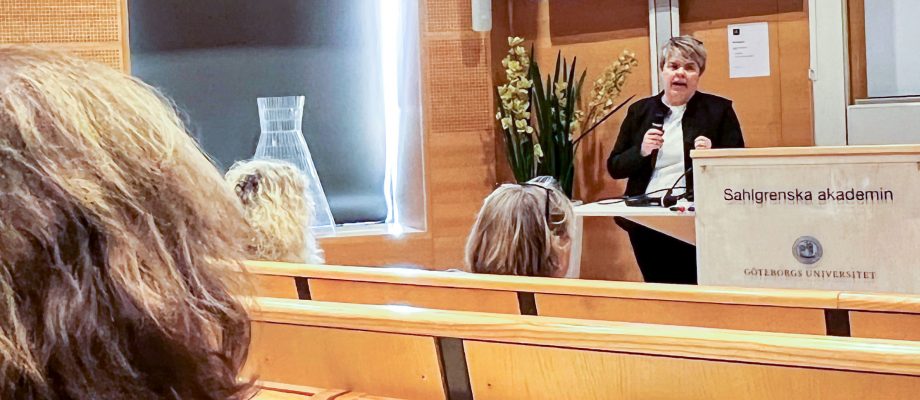FACULTY DIALOG. The General Academy Meeting on Wednesday November 16 was held in the Arvid Carlsson Auditorium and included five brief presentations focusing on work with profile areas and construction projects.
The hybrid meeting could also be followed via Zoom. This article provides an overview of the meeting; for those who want to see the complete meeting, a video (Swedish only) is available until November 30.

Dean Agneta Holmäng’s introduction was followed by Vice Dean Lena Carlsson Ekander. At the time of the meeting, the Vice-Chancellor had not yet made the official decision on which five profile areas the University will apply for. A total of 12 proposals for profile areas have been submitted by the faculties, covering a wide range of topics.
Twelve proposed areas
However, both an advisory board and assessment panels at all faculties have been involved in a major prioritization process. As a result, the Research Board has proposed a short list of five areas, which has been endorsed by the Vice-Chancellor’s University Management Council and will most likely be approved shortly. Sahlgrenska Academy’s profile area (“Age-related disease and therapy development”) is on this list. So is the Faculty of Science’s proposed profile area (“Molecular Life Science”), which is also relevant to many researchers at Sahlgrenska Academy. The other three priority areas on the list are “A Sustainable Digital Society”, “Cultural Heritage and Sustainability: towards an integrated approach (CULTSUS)”, and “UGOT OCEAN”.

When the Vice-Chancellor has made a decision, a brief description will be formulated for the Swedish Research Council so that the recruitment of external experts can begin. However, Lena Carlsson Ekander believes the budget proposal contains wording that may suggest that work on profile areas might be postponed or may not be done at all. If the process continues as planned, Sahlgrenska Academy is prepared. Anders Rosengren and other staff who have been hard at work on the profile area are ready to make the necessary efforts when needed.
Rent proposal in December
The next speaker was Mats Lilja, the University’s representative in the rental negotiations for Sahlgrenska Life. According to the plan, a rental proposal for Sahlgrenska Life should now be ready, but inflation and unrest in the world has meant that the property developer Virtates needs to make further analyses of how these challenges impact the construction project. Rental proposals are expected to be submitted to the University in mid-December instead. Lilja noted that Sahlgrenska Life is a complex project requiring Region Västra Götaland to sign three different rental agreements. He also said that Sahlgrenska Academy’s representatives had done a very solid job preparing specifications for the building, with very effective planning of the premises.
Nursing staff trains with students

This was followed by a presentation by Agneta Ekman, who is assigned to work on teaching premises and study environments. The plans specify that Building 3 of Sahlgrenska Life will be a 23-story high-rise. Floors 6 and 7 will have teaching premises, and floors 17 and 18 will accommodate a new skills center.
Floors 6–7 will also have a restaurant where both staff and students will be able to buy or heat food. A new hybrid teaching hall will also be built, which can be easily refurnished to accommodate different types of meetings and teaching. It will also provide space for some new Active Learning Classrooms (ALCs) and new study places.
The new skills center on floors 17–18 will be shared with Sahlgrenska University Hospital, which is a unique arrangement in Sweden, according to Agneta Ekman. Both professional staff and students will be able to practice clinical skills, practice methods, and be assessed there. One of the two floors will be leased to the University and the other to the medical care system, but both parties will use the entire space together.
Six reasons for reconstruction
Marie Hornfelt, manager of Core Facilities and director of Experimental Biomedicine (EBM), presented an overview of the planned renovation of EBM. After several feasibility studies, the EBM steering committee has now decided to proceed with a careful renovation, with the actual work starting in 2024. Hornfelt listed six main reasons why the reconstruction is necessary: working environment, operations and animal room technology, health status and infectious disease control, efficient use of space, new functions and flexibility, and energy consumption and climate impact.
Before the actual work starts, a long planning process will be conducted over the next year, testing different renovation methods and conducting the necessary procurements. The aim is to minimize the impact on research and to keep it on schedule. Although the project seeks to minimize impacts, organizations will need to prepare for vibration, noise, and other disturbances. Sensitive research may need to take place elsewhere during the refurbishment, such as at AstraZeneca and/or Mikrobiologen on Guldhedsgatan, which can offer temporary facilities.
Premises adapted to new needs

Finally, Vice Dean Eric Hanse provided insight into the progress of discussions about the Earth Science Center. The School of Public Health and Community Medicine is currently spread out in different premises and wants to move into the premises of the Earth Science Center when it is vacated after the summer of next year. But Occupational and Environmental Medicine has announced that it wishes to remain in its existing premises at Medicinaregatan 16. And General Medicine at Sahlgrenska University Hospital has announced that it also wants to move into the Earth Science Center. The Earth Science Center is in good condition and offers several modern teaching premises: a lecture hall and two Active Learning Classrooms. Although the premises are fine, they need some adjustments before the department can move in, and this will be investigated in the spring.
Eric Hanse also mentioned that work is now underway with the Faculty of Science to design the basement level under the Salt & Syra restaurant.
BY: ELIN LINDSTRÖM











